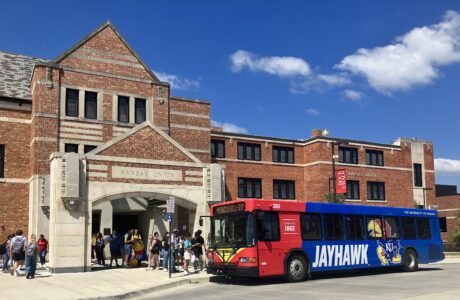KU boosts wages of nearly 190 employees who were earning less than a living wage; update on plan to close $27M wage gap on campus

photo by: Kim Callahan/Journal-World
The Kansas Union on the University of Kansas campus is pictured on Tuesday, Aug. 23, 2022.
Getting a degree from a university can be a good strategy to earn a living wage, and then some. But if you’re working at a university, well, a living wage can be a little more hit or miss.
At least that has been the experience at the University of Kansas, but officials now have come up with a plan to provide raises to the approximately 190 KU employees who were found to be earning less than a living wage.
Many of those employees were landscapers, maintenance workers, custodians and other similar types of positions, Jeff DeWitt, KU’s chief financial officer, told the Journal-World in an interview. Many of them were earning wages in the $12- to $14-an-hour range, he said.
Now, each one of them is earning at least $17.42 per hour, DeWitt said. For some employees, it is more than a $10,000-per-year raise.
“It is a huge deal, and it is sad when you have people working for you who have to have two or three jobs just because they can’t make a living wage,” DeWitt said.
DeWitt said the raises became effective July 1, and the new program now means that no full-time employee of the university should be earning less than the $17.42-per-hour level.
DeWitt said KU chose the $17.42-per-hour mark not because it represents an official living wage for Lawrence, but rather because it is the minimum wage amount that the federal government requires its contractors be paid. DeWitt said that seemed like a reasonable marker, and one that KU could figure out how to responsibly fund this school year.
The city of Lawrence doesn’t have an official living wage. The closest the city has is a Lawrence City Hall requirement that companies that receive a tax abatement pay their employees a wage that is at or above a wage floor, which is equal to 130% of the federal poverty level for a family of three. For 2024, that wage floor amount is $16.14 an hour. Other private organizations have calculated a living wage for Lawrence to be closer to $20 an hour.
DeWitt said KU may build to a higher wage level in the future, but it was important that KU address the issue this year, for a variety of reasons.
“This is important not only from an equity perspective but to reduce the high turnover of staff,” DeWitt said.
KU is seeing those turnover problems in areas beyond the maintenance and custodial departments. As the Journal-World reported in May, a KU-commissioned study determined that the university has a $27 million wage gap. The gap measures what staff members at KU are making compared to similar positions in the private sector in the area, and also measures what faculty members are earning in comparison to their peers at other national research universities.
University leaders have said that closing that wage gap is a major priority for the university, but it is not clear how much, if any, the gap will be closed in the coming school year.
As the Journal-World reported Wednesday, KU is giving a 2% cost-of-living raise to virtually all university employees. That is less than the 2.5% wage increase last year, and also is less than the 2.5% increase that KU officials had been projecting as an increase for the coming school year.
DeWitt told the Journal-World that the decision to go with a 2% increase was driven by a key consideration — it was the amount that the university could fund without dipping into its cash reserves.
“Our goal was to provide a cost-of-living increase as close to inflation as possible to prevent us from falling further behind in market pay while achieving a structurally-balanced budget — revenues equal expenditures — by the end of the year,” DeWitt said via email.
KU has been using cash reserves to fund general operations of the university since 2021. KU is expected to have just less than $20 million in general-use cash in fiscal year 2025, which began in July. That’s down from about $40 million in general use cash that KU had in fiscal year 2022.
DeWitt has long targeted this current fiscal year as the one where KU has to end its drawdown of cash reserves in order to remain financially sustainable. Funding future wage increases — and closing the $27 million wage gap — will be partially dependent upon future state funding and largely dependent on KU generating new revenue through its strategic plan.
That plan has multiple facets. KU hopes to generate new revenue through conventions and conferences that will use university spaces, including new space at the renovated David Booth Kansas Memorial Stadium. The university is also counting on new revenue streams through an expansion in online degrees and other class structures that will open the university up to more nontraditional students.
DeWitt said he is thus far pleased with how the strategic plan is progressing. He said this will be the third consecutive year without overall budget cuts at the university, and it will be the third consecutive year that the university has funded cost of living increases. That should put the university in a good position to start addressing some of the bigger issues, like the $27 million wage gap, in future years, he said.
“We don’t have a structural deficit anymore,” DeWitt said of the university’s finances. “So now it is like, let’s attack the $27 million, let’s attack the facilities we need to get fixed, let’s attack getting improvement on our student success … Now we can finally start doing that. Before we were burning through cash.”







COMMENTS